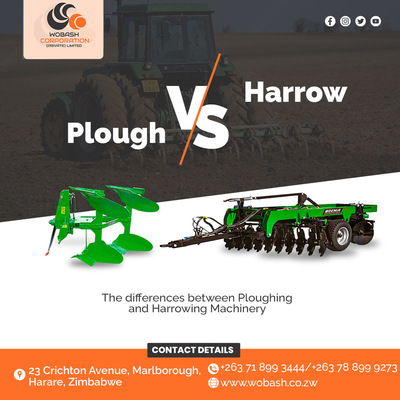
Plough and Harrow both are the farming implements used in land preparation. The following section will discuss their types, components, benefits, and popular models. People always have a question about why we should use a harrow when we are using a plough for land preparation. But they don’t know that both of the implements have different uses. For example, the plough is a primary tilling implement, whereas the harrow is used for secondary tilling.
Plough
Plough has been a vital agricultural tool since the beginning of farming. This farming implement is suitable for turning and breaking up the soil to bury crop residues and control weeds. Or in other words, a plough is a primary tillage tool for opening and loosening the soil. In the beginning the, wooden ploughs were in use. But the plough began to be made of iron with the revolution of technology.
The ploughing operations are done for removing crop residues of the last harvested crop and weeds. And it is the primary operation to cultivate any crop in the field. Moreover, plough agricultural implements till the land to more depth than harrows. And due to this, they leave some soil clods after the operation.
Types of Plough
Plough has several types, which have been in use till now. So, let’s know the types of plough.
Soil Turning Plough
Mouldboard Plough
Disc Plough
Reversible Plough
Subsoil Plough
Chisel Plough, etc.
Components of Plough
The components must be good quality for a farming tool or machine as components lead to performance. Poor quality of parts can minimise the performance of the device or can damage it. Let’s see the components of the plough.
1. Share Point
Share Point penetrates the soil and is a forward point of cutting edge.
2. Wing of Share
The cutting edge of the share’s outer end is the Wing Of Share. The component supports the bottom of the plough.
3. Cutting Edge
The front edge of the share to make a horizontal cut into the soil is the Cutting Edge.
4. Gunnel
The vertical face of share is Gunnel. It slides along the furrow wall and takes the side thrust of the soil. Also, it supports the plough against the furrow wall.
5. Wing Bearing
The wing of the share’s level portion is Wing Bearing.
6. Cleavage Edge
The edge of the share is the Cleavage Edge, forming joints between the share and mouldboard on the frog.
Benefits of Plough
Plough is a primary farming tool to provide farmers with many benefits, including
1. Breaking large clods of soil,
2. Tilling deeper,
3. Tilling without putting extra weight,
4. Enhancing the drainage property,
5. Preventing the frequent growth of weeds,
6. Turning the crop residues into decomposed manure, etc.
Harrow
Harrow is a powerful tractor-mounted implement for breaking up & smoothing out the soil. In this way, the effects of the harrow are distinct from the plough, which disturbs the soil deeply. Also, harrows are used to smooth the surface of the ground and break up the lumps left after ploughing. That’s why it comes under the secondary tilling implements category. Thus, when a farmer needs a delicate soil structure for a particular crop, he can use a harrow for it.
Apart from this, the harrow works for removing weeds and covering the sown seeds with soil. And that is the difference between harrow and cultivator. Also, the work of weed control makes harrow and cultivator similar in a concise manner.
Types of Harrow
We can see the different types of harrow around the world, but some of them are in regular practice. So, let’s see the kinds of harrow which are in practice.
1. Disc harrow
2. Guntaka
3. Spring tooth harrow
4. Spike tooth harrow
5. Triangular harrow
6. Bindha
7. Blade harrow
8. Zig-Zag harrow
7. Bodela
Components of Harrow
The harrow consists of many components to work efficiently. Following are the components of the harrow tool.
1. Disc
Discs are the revolving steel plates of circular and concave design used to cut the soil. The discs are manufactured with high-quality steel. And they have a size from 35 to 70 cm, which varies from model to model.
2. Gang Angle
The angle between axes of the gang is known as the gang angle.
3. Gang
The gang is the assembly of concave discs.
4. Gang Control Lever
A gang control lever is a leveller for operating the angling mechanism.
5. Gang Axle or Arbor Axle
Gang Axle is the component of a harrow on which the set of discs is mounted.
6. Spool or Spacer
The spool or spacer or a flanged tube is fitted on the gang axle.
7. Transport Wheel
The wheels provide a reach to the road for this machine.
8. Bearing
Bearings are vital for counteracting the end thrust.
9. Weight Box
A weight box is mandatory for putting extra weight on the machine.
10. Scraper
For protecting the machine from clogging, a scraper is used.
Benefits of Harrow
Harrow has distinct advantages for preparing the land, including
1. Breakups the soil clods and surface crust,
2. Cultivating the ground with great precision,
3. Raising the aeration and surface uniformity,
4. Eliminating the emerged weeds,
5. Working in any type of soil,
6. Pulverising the soil, etc.



.png)
.png)